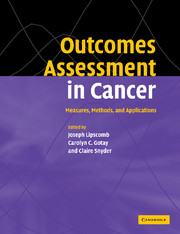Book contents
- Frontmatter
- Contents
- List of contributors
- Acknowledgments
- 1 Introduction to Outcomes Assessment in Cancer
- Health-related quality of life in cancer: general concepts and generic measures
- Assessing health-related quality of life during treatment
- Assessing health-related quality of life across the cancer continuum
- Measuring the experience and needs of cancer patients and caregivers
- Methodological considerations in applications to cancer outcomes research
- Modern psychometric theory in cancer outcomes research
- Assessing the economic impact of cancer
- Research and policy implications
- 26 Data for cancer outcomes research: identifying and strengthening the empirical base
- 27 Use of health-related quality of life measures by industry and regulatory agencies in evaluating oncology therapies
- 28 Reflections on COMWG findings and moving to the next phase
- Invited papers
- Index
- References
28 - Reflections on COMWG findings and moving to the next phase
Published online by Cambridge University Press: 18 December 2009
- Frontmatter
- Contents
- List of contributors
- Acknowledgments
- 1 Introduction to Outcomes Assessment in Cancer
- Health-related quality of life in cancer: general concepts and generic measures
- Assessing health-related quality of life during treatment
- Assessing health-related quality of life across the cancer continuum
- Measuring the experience and needs of cancer patients and caregivers
- Methodological considerations in applications to cancer outcomes research
- Modern psychometric theory in cancer outcomes research
- Assessing the economic impact of cancer
- Research and policy implications
- 26 Data for cancer outcomes research: identifying and strengthening the empirical base
- 27 Use of health-related quality of life measures by industry and regulatory agencies in evaluating oncology therapies
- 28 Reflections on COMWG findings and moving to the next phase
- Invited papers
- Index
- References
Summary
Introduction
The perspectives of individuals who receive cancer-related interventions provide important information about diagnosis, treatment, and continuing care. These patient-centered data also have implications for the effectiveness of interventions and the quality of cancer care and can thus be an important resource for decision makers who deliver, pay for, regulate, and evaluate cancer care. At the same time, measuring such outcomes poses challenges different from those of biomedical outcomes. In particular, certain patient-centered outcomes (e.g., health-related quality of life) are subjective, by design, and not directly verifiable by physiological or other objective indicators, while others (e.g., economic outcomes) are not generally part of standard clinical information systems. Because of the growing importance of outcomes data, the National Cancer Institute (NCI) convened the Cancer Outcomes Measurement Working Group (COMWG) to assess the current state of the science and to provide recommendations for future research to improve the field. This book reports on findings from the COMWG effort.
The COMWG focused on three primary outcomes — health-related quality of life (HRQOL), patient needs and satisfaction, and economic burden — in the four cancers that affect the largest numbers of individuals in the USA: breast, colorectal, lung, and prostate. The group also considered outcomes measurement across the entire spectrum of cancer prevention, treatment, survivorship, and end-of-life care. COMWG members provided critical review and discussion of current literature in specified topics, as well as identification of areas where more work is needed.
- Type
- Chapter
- Information
- Outcomes Assessment in CancerMeasures, Methods and Applications, pp. 568 - 583Publisher: Cambridge University PressPrint publication year: 2004

